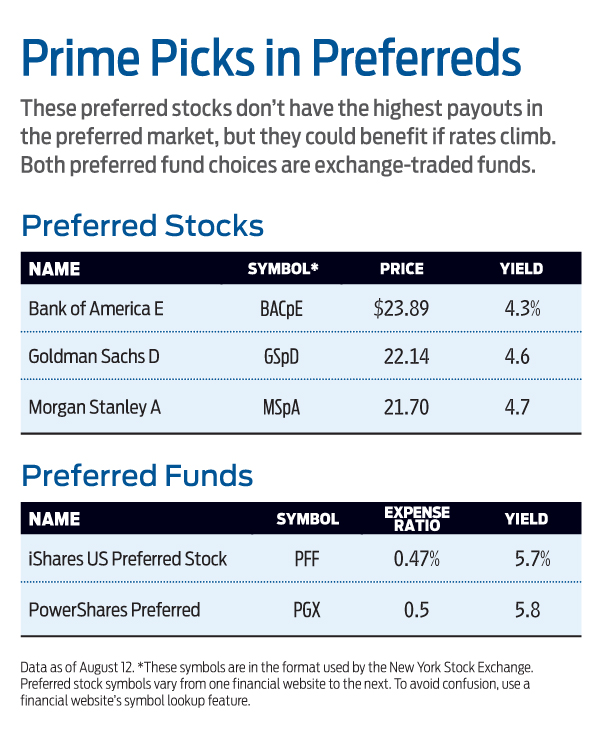How Retirees Can Earn Income From Preferred Stocks
With yields often exceeding 5%, these shares can deliver steady income.


In this income-starved world, is it possible to find satisfying yields without extra side orders of risk? Yes, if you're willing to study up on one of the more obscure areas of the market: preferred stocks.
Preferred shares, issued largely by financial firms, telecom companies and utilities, have some attributes of both stocks and bonds. They offer regular income payments, which are generally higher than the interest you'd earn on a bond from the same company. They're called "preferred" because a company must pay dividends on its preferred shares before any dividends on its common stock.
"Preferreds are one of the very few places where you can still get a reasonable income stream by historical standards," says William Scapell, who manages preferred funds at Cohen & Steers. Although preferreds are generally issued by investment-grade companies, they often yield 5% or more -- well above the 3% you'd get on a typical investment-grade corporate bond. And there's a tax advantage: Many preferred payouts are qualified dividend income, taxed at your long-term capital-gains rate (which is 0% for couples with taxable income under $75,300 in 2016).
From just $107.88 $24.99 for Kiplinger Personal Finance
Become a smarter, better informed investor. Subscribe from just $107.88 $24.99, plus get up to 4 Special Issues

Sign up for Kiplinger’s Free Newsletters
Profit and prosper with the best of expert advice on investing, taxes, retirement, personal finance and more - straight to your e-mail.
Profit and prosper with the best of expert advice - straight to your e-mail.
Yet the case for preferreds has been bolstered in recent years as the financial institutions that issue the majority of these securities have shown increasing strength. Since the 2008-09 financial crisis, new regulations have forced banks to build up capital, tone down riskier activities such as trading, and focus more on the traditional business of lending -- moves that help provide steady and secure payments for preferred shareholders.
And at a time when dividend growth is slowing -- Standard & Poor's 500-stock index yields about 2% -- preferreds look even more appealing.
Their unique traits also make preferreds good diversifiers for portfolios full of plain-vanilla stocks and bonds. Because they don't benefit from improving earnings prospects the way common stocks do, they have relatively low correlation with stocks. They also complement high-yield bond holdings. In the high-yield arena, there tend to be many more economically sensitive issuers and few financials, Scapell says, whereas preferreds are dominated by financial issuers.
Don’t dive into preferreds expecting big price gains. Like most income-producing securities, preferreds have been bid up lately. Many exchange-listed preferreds -- those that can be easily traded by individual investors and typically have a $25 par value -- are now trading above that level, says Douglas Christopher, senior analyst at brokerage firm D.A. Davidson. Focus on preferreds trading at or below $25. The higher the premium, Douglas says, the more volatility you can expect.
Weighing the Risks
As with all types of income investing, it's generally a bad idea to snap up the highest yield you can find. Instead, weigh the income you'll receive against the key risks you might face: rising rates and issuers redeeming the shares or suspending preferred payouts.
A sharp rise in interest rates would hurt preferred stocks. But most analysts don't see that in the cards. The more likely slow-and-steady rate increases would actually benefit the banks that issue many preferred shares by boosting net interest margins, says Heidi Richardson, head of investment strategy for U.S. iShares at BlackRock.
The impact of rising rates would also depend on what type of preferred you're holding. While many preferreds pay fixed rates (a negative for investors when rates rise), some offer adjustable rates or "fixed to float" payments. That means the rate stays fixed for a set period (often five or 10 years), then floats based on fluctuations in a benchmark such as the London interbank offered rate, or LIBOR. Some money managers are using such securities to build preferred portfolios that stand to benefit from rising rates. Cohen & Steers, for example, last year launched a Low Duration Preferred and Income Fund, which holds a mix of floating-rate and fixed-to-float preferreds and short-term corporate bonds. "That fund could have some price appreciation if rates rise," Scapell says.
Preferreds are generally callable, meaning issuers have a right to redeem shares at a specific price after a certain number of years. Always check the call date before you buy: A juicy yield may look less tempting if the shares might soon be redeemed, leaving you to reinvest your money at potentially lower rates. Bank of America series I preferred shares, for example, yield 6.2%. But they trade at $26.70 and can be redeemed at their $25 par value next year. (That makes the "yield to call" just 0.3%.) With Bank of America showing increasing financial strength, there's a good chance the bank will redeem these shares and issue new preferreds at lower rates, Christopher says.
Pay attention to the financial stability of the issuer, too. Preferred stock dividends, like common stock dividends, can be suspended when a company falls on hard times. Some preferred issuers cut dividends during the financial crisis, and the S&P US Preferred Stock Index sank 26% in 2008.
While banks have emerged stronger from the financial crisis, investors should be wary of issuers that are more exposed to economic ups and downs and commodity-price swings. Energy companies Chesapeake Energy and Vanguard Natural Resources, for example, suspended preferred-share dividends early this year amid plummeting oil prices. "I would never buy a preferred from a cyclical company," Scapell says. "There's just too much risk that they'll stop paying you."
If your preferred shares are "cumulative," the company must pay any preferred dividends it skipped before it can pay out anything to common stock holders. If your preferreds are "non-cumulative," however, the company can simply resume dividend payouts and ignore previous missed payments. Find the basics on a preferred stock's payment structure, call date and other details, plus a link to the prospectus, at the free website QuantumOnline.com.
Sorting Through Preferreds
So how can you find the strongest preferred issuers? Christopher likes to start by looking for companies that are repurchasing shares or raising their common-stock dividends. "That's usually very positive in our view for the preferred holders, because the preferred dividends are paid prior to the common dividend," he says.
Banks are a prime hunting ground for preferred investors today, many money managers and analysts say. With their credit quality continuing to improve, "we have a very favorable view on U.S. bank preferred stocks," says Eric Chadwick, president and portfolio manager at fund firm Flaherty & Crumrine, in Pasadena, Calif.
Christopher likes several adjustable-rate financial preferreds trading below par value. With yields between 4% and 5%, these preferreds don't have the highest payouts around. But "we're not reaching for yield," Christopher says. "What we're trying to do is buy some securities that could benefit if rates were to move higher."
The preferreds listed below have a large number of shares changing hands daily. But that’s not always the case. Some preferreds are very thinly traded and can be costly to buy or sell, so check the trading volume before you buy. And while the preferreds listed here pay out qualified dividend income, some pay out ordinary income. A site such as QuantumOnline.com will help you decipher the tax treatment. To avoid the complexities of picking preferreds on your own, consider an exchange-traded fund such as iShares US Preferred Stock or PowerShares Preferred. These ETFs hold hundreds of preferreds, but in a reflection of the preferred market, they’re highly concentrated in the financial sector.
No-load fund investors will find slim pickings in the preferred category. But you can find high- quality no-load funds that hold preferreds alongside dividend-paying stocks and other holdings. American Century Equity Income (symbol TWEIX), for example, devotes a slice of assets to preferreds and is a member of the Kiplinger 25, a list of our favorite no-load mutual funds.

Profit and prosper with the best of Kiplinger's advice on investing, taxes, retirement, personal finance and much more. Delivered daily. Enter your email in the box and click Sign Me Up.

-
 The Best Vanguard Bond Funds to Buy
The Best Vanguard Bond Funds to BuyInvestors seeking the best Vanguard bond funds can pick between mutual funds and ETFs spanning maturities, credit qualities, tax treatment and geographies.
-
 Are You Afraid of an IRS Audit? 8 Ways to Beat Tax Audit Anxiety
Are You Afraid of an IRS Audit? 8 Ways to Beat Tax Audit AnxietyTax Season Tax audit anxiety is like a wild beast. Here’s how you can help tame it.
-
 The Kiplinger Letter's 10 Forecasts for 2026
The Kiplinger Letter's 10 Forecasts for 2026The Kiplinger Letter Here are some of the biggest events and trends in economics, politics and tech that will shape the new year.
-
 457 Plan Contribution Limits for 2026
457 Plan Contribution Limits for 2026Retirement plans There are higher 457 plan contribution limits in 2026. That's good news for state and local government employees.
-
 Medicare Basics: 12 Things You Need to Know
Medicare Basics: 12 Things You Need to KnowMedicare There's Medicare Part A, Part B, Part D, Medigap plans, Medicare Advantage plans and so on. We sort out the confusion about signing up for Medicare — and much more.
-
 The Seven Worst Assets to Leave Your Kids or Grandkids
The Seven Worst Assets to Leave Your Kids or Grandkidsinheritance Leaving these assets to your loved ones may be more trouble than it’s worth. Here's how to avoid adding to their grief after you're gone.
-
 SEP IRA Contribution Limits for 2026
SEP IRA Contribution Limits for 2026SEP IRA A good option for small business owners, SEP IRAs allow individual annual contributions of as much as $70,000 in 2025, and up to $72,000 in 2026.
-
 Roth IRA Contribution Limits for 2026
Roth IRA Contribution Limits for 2026Roth IRAs Roth IRAs allow you to save for retirement with after-tax dollars while you're working, and then withdraw those contributions and earnings tax-free when you retire. Here's a look at 2026 limits and income-based phaseouts.
-
 SIMPLE IRA Contribution Limits for 2026
SIMPLE IRA Contribution Limits for 2026simple IRA For 2026, the SIMPLE IRA contribution limit rises to $17,000, with a $4,000 catch-up for those 50 and over, totaling $21,000.
-
 457 Contribution Limits for 2024
457 Contribution Limits for 2024retirement plans State and local government workers can contribute more to their 457 plans in 2024 than in 2023.
-
 Roth 401(k) Contribution Limits for 2026
Roth 401(k) Contribution Limits for 2026retirement plans The Roth 401(k) contribution limit for 2026 has increased, and workers who are 50 and older can save even more.